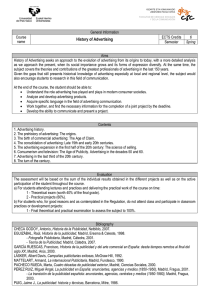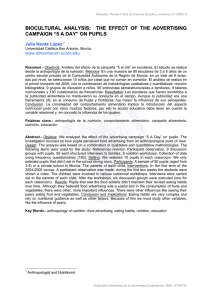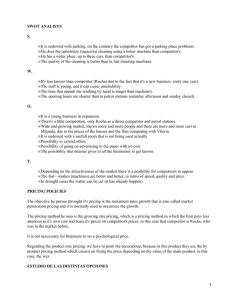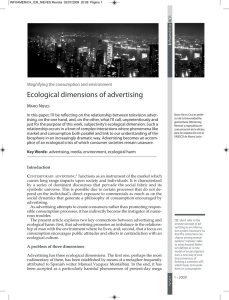The Paradigm Shift in Advertising and its Meaning for
Anuncio
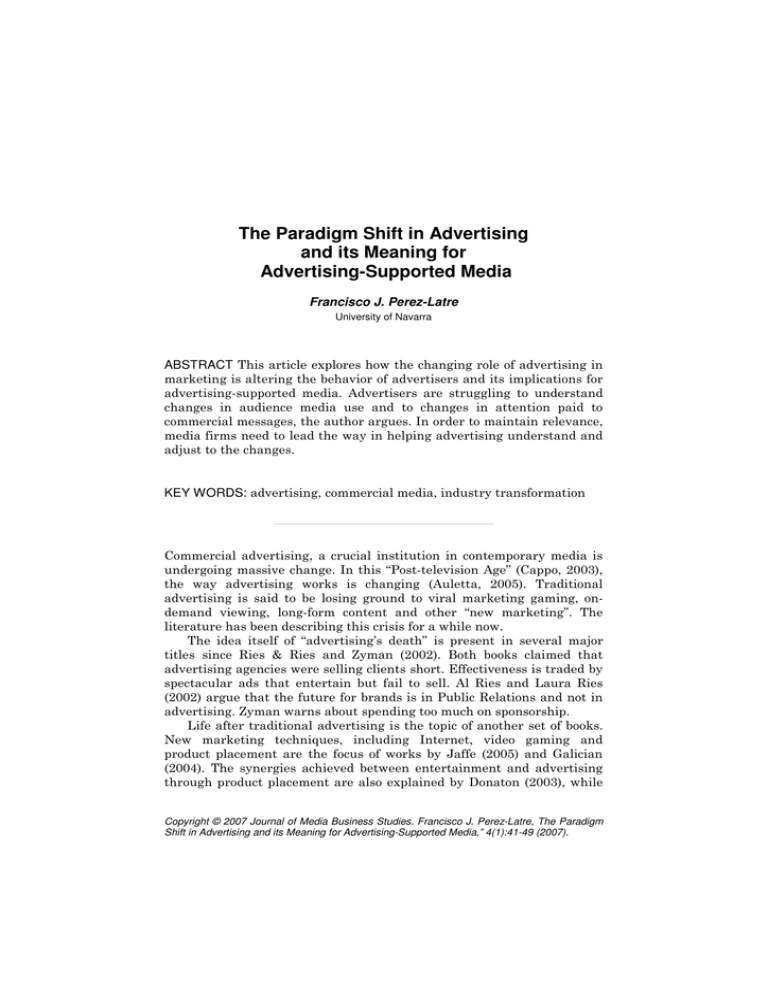
The Paradigm Shift in Advertising and its Meaning for Advertising-Supported Media Francisco J. Perez-Latre University of Navarra ABSTRACT This article explores how the changing role of advertising in marketing is altering the behavior of advertisers and its implications for advertising-supported media. Advertisers are struggling to understand changes in audience media use and to changes in attention paid to commercial messages, the author argues. In order to maintain relevance, media firms need to lead the way in helping advertising understand and adjust to the changes. KEY WORDS: advertising, commercial media, industry transformation Commercial advertising, a crucial institution in contemporary media is undergoing massive change. In this “Post-television Age” (Cappo, 2003), the way advertising works is changing (Auletta, 2005). Traditional advertising is said to be losing ground to viral marketing gaming, ondemand viewing, long-form content and other “new marketing”. The literature has been describing this crisis for a while now. The idea itself of “advertising’s death” is present in several major titles since Ries & Ries and Zyman (2002). Both books claimed that advertising agencies were selling clients short. Effectiveness is traded by spectacular ads that entertain but fail to sell. Al Ries and Laura Ries (2002) argue that the future for brands is in Public Relations and not in advertising. Zyman warns about spending too much on sponsorship. Life after traditional advertising is the topic of another set of books. New marketing techniques, including Internet, video gaming and product placement are the focus of works by Jaffe (2005) and Galician (2004). The synergies achieved between entertainment and advertising through product placement are also explained by Donaton (2003), while Copyright © 2007 Journal of Media Business Studies. Francisco J. Perez-Latre, The Paradigm Shift in Advertising and its Meaning for Advertising-Supported Media,” 4(1):41-49 (2007). 42 Perez-Latre-Paradigm Shift in Advertising exploring the history of product placement, which is currently perhaps the most apparent alternative to traditional advertising. The strength of online advertising and its cost-effectiveness is also shown through a variety of works that explain how search engines like Google are changing advertising strategies forever. Marketing without advertising has also become a frequent topic in the academic and managerial conversation. Nyren (2005) explains that perhaps there is no need to work with an advertising agency. BUILDING BRANDS IN A DIFFERENT MEDIA LANDSCAPE Brands are not built around the 30-second commercial anymore: consumers’ alienation with cluttered media has become a factor. The “2005 Best Global Brands special report” at Business Week underlined the industry turnaround: “the best brand builders are also intensely creative in getting their message out. Many of the biggest and most established brands, from Coke to Marlboro, achieved their global heft decades ago by helping to pioneer the 30-second TV commercial. But it is a different world now. The monolithic TV networks have splintered into scores of cable channels, and mass-market publications have given way to special-interest magazines aimed at smaller groups. Given that fragmentation, it’s not surprising that there’s a new generation of brands, including Amazon.com, eBay, and Starbucks that have amassed huge global value with little traditional advertising. They’ve discovered new ways to captivate and intrigue customers. Now the more mature brands are going to school on the achievements of the upstarts and adapting the new techniques for themselves” (Business Week, August 1, 2005). In this context there is an increasing premium for innovation. Writes Daniel Gross in Fortune magazine: “Thanks to the Internet, advertising is going through its first true paradigm shift since the advent of television half a century ago (…) The Internet is expected to attract close to $8 billion from national advertisers this year, still fairly modest but up 15% from 2004. So ‘offline’ media companies are redoubling their online efforts, and Madison Avenue is scrambling to cope” (Fortune, July 25, 2005). Advertising remains a very powerful economic force and advertisers are spending more than ever. But much of the growth occurs in California, in the headquarters of companies like Google and Yahoo. Integration is a major driving force: “That simple solution to advertising doesn’t exist anymore. Television is not as dominant as it once was. A whole world of cable and satellite channels is now available to smart marketers. One must devote more time to media evaluation and selection, and it can produce more effective advertising. That is exactly what clients are looking for –more answers to their marketing problems. And aside from the proliferation of television, cable and satellite signals, there has been substantial growth in all other forms of marketing –sales Journal of Media Business Studies 43 promotion, direct marketing, sponsorship, not to mention the Internet”(Cappo, 2003, 151). Advertisers are indeed exploring many new avenues. Billboard advertising is being used in innovative ways: “Out-of-home advertising, long considered a backwater on Madison Ave., is getting tougher to ignore as it branches out beyond the old-fashioned billboard. New technologies are transforming out-of-home ads, a sector which includes roadside billboards, ads on buses and trains and now even coasters in bars. As advertisers find it harder to reach consumers through television and radio, the increasing array of out-of-home ads is looking more attractive (The Wall Street Journal, July 21, 2005). Another growth area is “branded entertainment”, where advertisers and broadcasting executives thoroughly plan shows to achieve maximum brand impact. The stated goal is to avoid traditional advertising’s pitfalls: “to tightly weave a brand or product into content and to counter consumers growing habit of zapping, zipping or otherwise avoiding traditional commercial pitches” (The New York Times, July 21, 2005). Business Week echoed similar developments: “some marketers have worked to make their brand messages so enjoyable that consumers might see them as entertainment instead of an intrusion. When leading brands are seen on TV they’re apt to have their own co-starring roles (…) rather than just lending support during the commercial breaks. All are trying to create a stronger bond with the consumer” (Business Week, August 1, 2005). Besides, mass media advertising has long suffered from accountability problems: “Everyone complains about the inability to determine the return on investment from advertising spending, but no one seems satisfied with what is being done about it. Senior marketers are increasingly intent on figuring out what they are doing right—and wrong—as the cost of peddling goods and services climbs each year, along with the difficulty of reaching potential customers” (The New York Times, July 20, 2005). The survey was conducted in April by the advertiser association and two partners, Marketing Management Analytics, part of the Aegis Group, and Forrester Research. 61.5 percent of the survey respondents said it was important to them to define, measure and take concrete steps in the area of advertising accountability. But only 19 percent said they were satisfied with their ability to take those steps. And 73 percent of respondents were not confident that they understood the effects that an advertising or marketing campaign could have on sales. When asked if they agreed with the statement, "I would be able to forecast the impact on sales" of a 10 percent cut in marketing spending, 63 percent said no (The New York Times, July 20, 2005). More than two centuries of advertising in media has not brought a significant improvement in that regard. Advertising’s impact on sales is uncertain and advertisers might have other means to look for consumers. 44 Perez-Latre-Paradigm Shift in Advertising In the new context, “the era of building brands namely through mass media advertising is over. The predominant thinking of the world’s most successful brand builders these days is not so much the old game of reach (how many consumers see my ad) and frequency (how often do they see it), but rather finding ways to get consumers to invite brands into their lives. The mass media won’t disappear as a tool. But smart companies see the game today as making bold statements in design and wooing consumers by integrating messages so closely into entertainment that the two are all but indistinguishable” (Business Week, August 1, 2004). Clutter and media fragmentation have long been serious hurdles for traditional media. There is a problem of over marketing that overwhelms publics and undermines commercial communication efforts. ADVERTISING EXPENDITURES: PRINT AND TERRESTRIAL BROADCASTING LOSE GROUND Generally speaking, traditional media where advertising spending is highest are continually decreasing in media audience and advertising share. Looking at measured advertising expenditures we can analyze what has been happening in the last decade in the largest advertising market in the world (United States), the two largest European Union markets (Germany and the UK) and the European Union at large. The trends are apparent. Dailies are losing ground, threatened by free newspapers and online news outlets. Whenever there is a development in cable and satellite television, terrestrial television enters into a downward spiral. By 2002, cable advertising spending in the USA was higher that in the networks. Their total advertising media share is just about 6.8% of the overall market. In the UK, paid television development has provoked an even higher decrease for terrestrial television in the last decade, losing more than five share points in the overall advertising market. Only in Germany television share has grown. But we still lack separate figures for terrestrial television and cable, in a country with large cable penetration: 73.5% of Germans older than three have access to cable television. Terrestrial television is also losing share to cable and satellite in Austria, another country where we do have separated figures and that it is also interesting because of its similarity to the German market in certain aspects (see table 4). On the other side, radio and outdoor advertising tend to grow and even more clearly direct mail and the internet, even though actual figures for internet advertising are probably higher that those measured. In the EU-15 (see table 5), the 1994-2005 decade has seen a retreat in print media share. Television has increased slightly because of deregulation of the broadcasting markets or increase in cable and satellite expenditures. Radio and outdoor remain stable with a tendency to improve, and internet has emerged as a significant player, confirming the trends apparent in the largest markets. Journal of Media Business Studies 45 Table 1. United States Dailies Magazines Network TV Cable TV Radio Outdoor Internet 1995 2000 2005 34,1 11,2 10 5,3 10,2 1 0 29,8 10,3 8,8 8,6 11,2 2,6 4,2 26,5 9,3 9 12,1 10,5 2,9 7,4 % Change 1995-2005 -7,6 -1,9 -1 6,8 0,3 1,9 7,4 Source: The European Advertising and Media Forecast, October 2005, July 2006. Table 2. United Kingdom Dailies Magazines Terrestrial TV Cable/Satellite TV Radio Outdoor Internet 1995 2000 2005 38,4 16,2 28,2 2 37,6 15,1 25,5 4,1 32,8 12,6 21,3 6,1 % Change 1995-2005 -5,6 -3,6 -6,9 4,1 3,1 4,3 0 4 5,2 1,1 3,5 6 9,1 0,4 1,7 8 Source: The European Advertising and Media Forecast, October 2005, July 2006. Table 3. Germany Dailies Magazines Television Radio Outdoor Internet 1995 2000 2005 45,9 18,5 20,9 3,7 3,3 - 43,2 17,7 24,1 3,7 3,8 0,8 40,5 16,5 24,5 4,1 4,8 2,1 % Change 1995-2005 -5,4 -2 3,6 0,4 1,5 2,1 Source: The European Advertising and Media Forecast, October 2005, July 2006. Perez-Latre-Paradigm Shift in Advertising 46 Table 4. Austria Dailies Magazines Terrestrial TV Cable/Satellite TV Radio Outdoor Internet 1995 2000 2005 44,5 16 20.7 - 43,4 18.4 18.8 3.6 44 16.5 13.8 7 10.4 6.1 - 7.4 5.3 - 7.2 6.5 1.2 % Change 1995-2005 -0.5 0.5 -6.9 7 -3.2 1,5 1.2 Source: The European Advertising and Media Forecast, October 2005, July 2006. Table 5. EU-15 Media Share 1994-2005 Medium Newspapers Magazines Television Radio Outdoor Internet 1994 37.8 17 27.8 4.3 4.6 - 2005 32 14.7 30.1 5 5.4 4 Change % -5.8 -2.3 2.3 0.7 0.8 4 Source: The European Advertising and Media Forecast, Vol. 20, no 5, July 2006. This is happening in spite of the fact that media planning is probably rewarding traditional media, which have more systematic quantitative measures. However, audiences seem to be going in a different direction. There is no other way to plan media that are “consumed” in a different way than traditional media. Traditional media see themselves in a position where there is a need to build stronger brands to achieve differentiation, be relevant to audiences and get into media plans. For example, the fact that free newspapers already account for 11.8% of total advertising spending in Germany or 9.6% in France can no longer be ignored (see Table 6). Internet is already a significant player in the overall market. Table 7 lists the countries where internet advertising’s share is above 2%. Journal of Media Business Studies 47 Table 6. Free papers advertising expenditure as a percentage of total advertising expenditures, selected countries (2005) Free papers total advertising share (%) Germany 11.8 France 9.6 Sweden 6.4 Finland 5.1 Denmark 2.6 Source: The European Advertising and Media Forecast, Vol. 20, Number 5, July 2006. Table 7. Countries where internet advertising is above 2% in overall expenditures (2005) Internet advertising as % of overall expenditures United Kingdom 9.1 Sweden 7.6 Norway 7.5 Denmark 6.2 Japan 6.1 Canada 4.3 France 3.4 Finland 2.8 Netherlands 2.6 Belgium 2.2 Germany 2.1 Czech Republic 2.1 Source: The European Advertising and Media Forecast, Vol. 20, Number 5, July 2006. Media approaches need to be changed in the new environment. A thorough research about audience media usage is a must. Media plans have to be changed so that they become closer to the brand communication’s message. Planning carries a message to audiences. But audiences do not listen as they used to. There is a relevant degree of media overlap and multitasking. The best television brands are conscious of the classic commercial’s crisis and look for fresh opportunities in media contents using product placement and sponsoring. Corporate communication also acquires greater relevance. Planners will probably need to change habits and become experts in media usage and “consumption” by audiences at large. Only thus the media function will be efficient, connecting with audiences and putting its knowledge to serve and protect brands. Media planning will need to adapt itself to media avenues where metrics like ratings, shares, GRPs or 48 Perez-Latre-Paradigm Shift in Advertising CPT are less relevant. Changes are also effects of a revolution in media use by the citizens: time spent and the impact of technology in everyday life, leisure time and lifestyles. Consumers, enabled by technology, are increasingly in control of their media consumption. UNDERSTANDING AUDIENCE CHANGE Audience’s change needs to be properly understood. The last decades of the 20th century gave birth to an audience with ever-increasing choices. It aims to be part of the communication process. The very notion of mass communication is disputed. New information technologies like personal computers, video, the Internet, e-mail, digital television, DVR, satellite radio or cell phones are expanding rapidly. That expansion is not likely to be thwarted or slowed down. This kind of change has effects that necessarily should influence audience understanding. The concern should not only be audience size, reach and frequency. In the new digital, consumer-centered paradigm, frequency and reach have been relegated into a minor advertising role. The decision is largely one that takes into account the plethora of communication tools at the disposal of persons, brands, firms, and institutions. Media executives often say they know their audiences extremely well, but considering them as stakeholders in their decisions is a different thing. Some think more often of their advertisers. However, it seems that advertisers are better served when audiences are well known and properly understood. Cluttered advertising environments are negative for audiences but are also really bad for advertisers: consumers have a lot of trouble remembering brands. More research would help executives to put themselves more in the audiences’ and advertisers’ shoes. This is an area where media have room for improvement: getting to know better the public they serve. Part of the problem for newspapers might have to do with this. And it is a major force behind the development of techniques like product placement. CONCLUSIONS The advertising industry is undergoing a momentous time of change worldwide. The crisis of the 30-second spot and the lackluster performance of traditional media like terrestrial television, print and radio are having a profound influence in advertising-supported media. In a way, the advertising industry is disrupted by technology. So they are terrestrial broadcasting, publishing and radio. Advertising follows consumers. And consumers are talking loud. They like good ads that travel increasingly around the internet. But they do not like excess. Technology makes increasingly difficult for advertising Journal of Media Business Studies 49 to appear as an interruption: consumers are more in control. This is the situation advertisers should read correctly: it is not the end of advertising, but it is a whole new context with significant implications in the way media space is sold. A better audience understanding will help companies in those industries to develop advertising strategies that are relevant to consumers. The emergence of online advertising, innovative out-of home solutions and “branded entertainment” will continue to draw researchers’ and industry attention. This situation calls for a revamp in the way advertising media plans are laid out. REFERENCES Auletta, Ken (2005). “The New Pitch”, The New Yorker, March 28. Cappo, Joe (2003). The Future of Advertising: New Media, New Clients, New Consumers in the Post-Television Age, McGraw-Hill, New York.. The European Advertising and Media Forecast, October 2005, July 2006, Vol. 20, Number 5, World Advertising Research Center, Henley-onThames. Donaton, Scott (2004). Madison & Vine, McGraw-Hill. Galician, Mary Lou (2004), Editor. Handbook of Product Placement in the Mass Media: New Strategies in Marketing Theory, Practice, Trends, and Ethics, Best Business Books. Jaffe, Joseph (2005). Life After the 30-Second Spot: Energize Your Brand With a Bold Mix of Alternatives to Traditional Advertising, John Wiley and Sons. Nyren, Chuck (2005), Advertising to Baby Boomers, Paramount Market Publishing. Ries, Al, Laura Ries (2002), The Fall of Advertising and the Rise of PR, Collins. Zyman, Sergio (2002). The End of Advertising as We Know It, Wiley. 50
